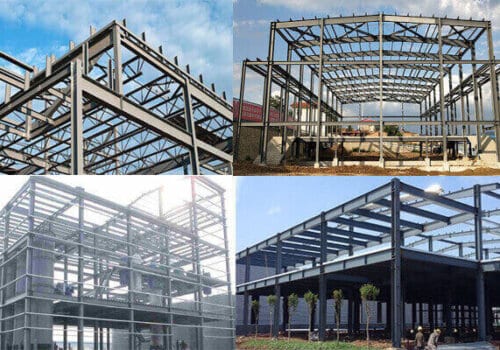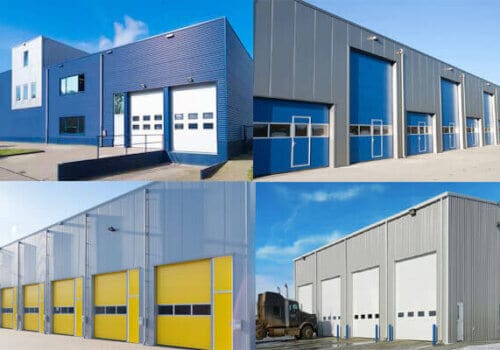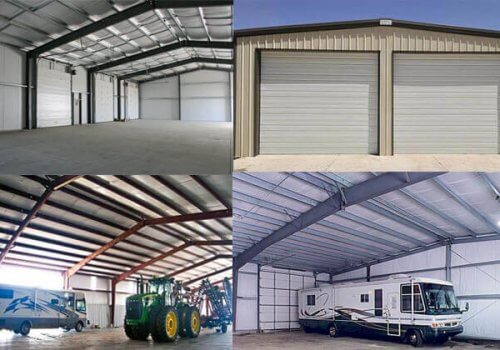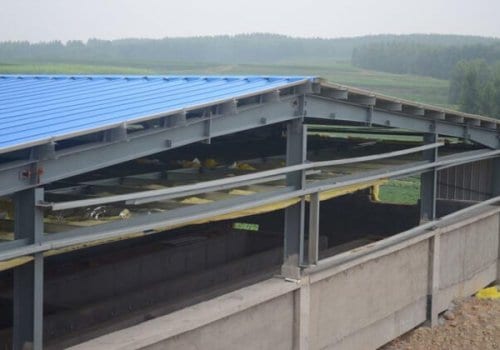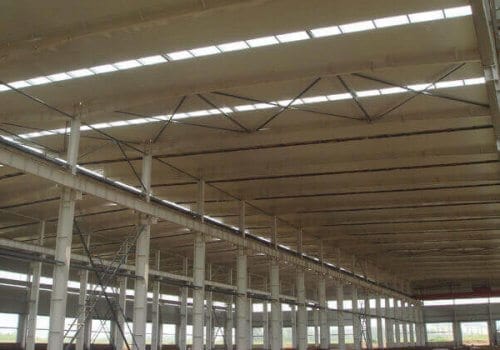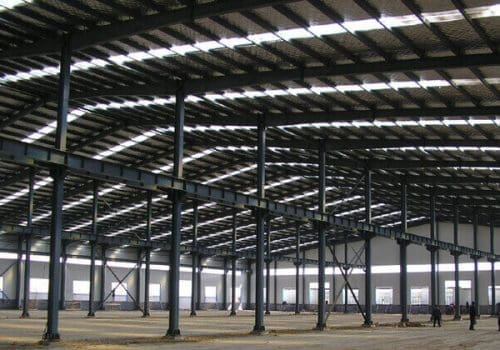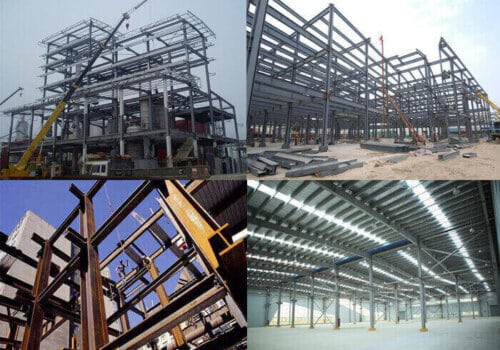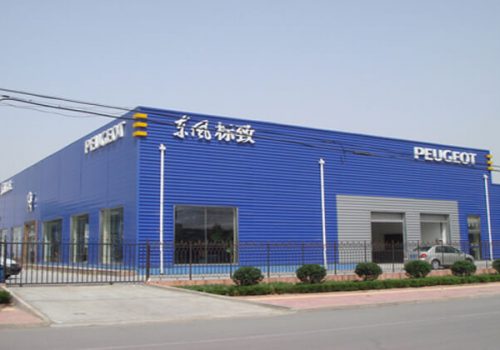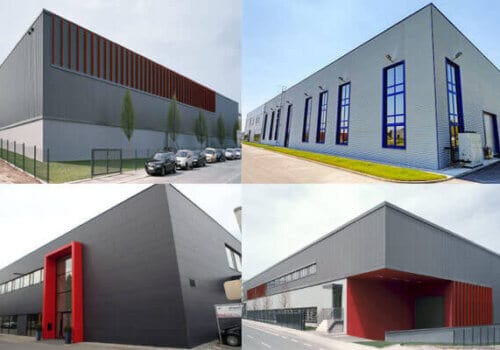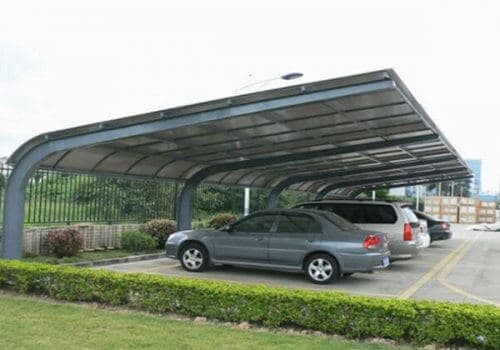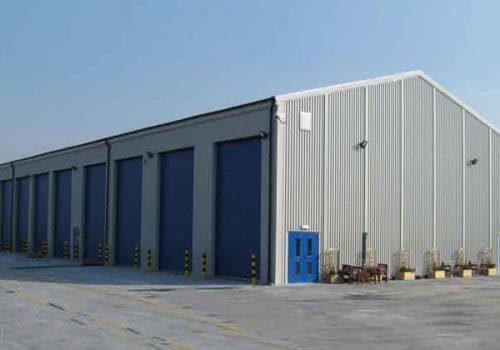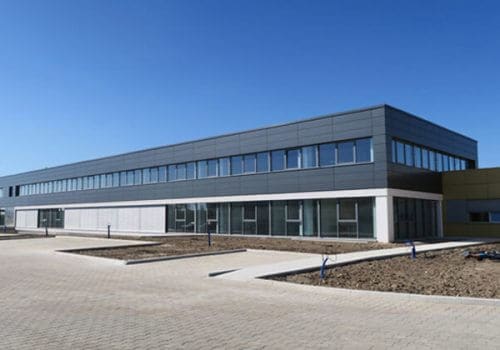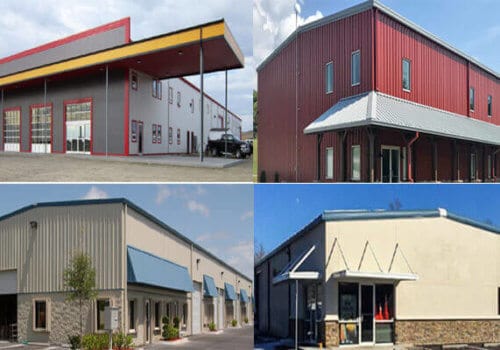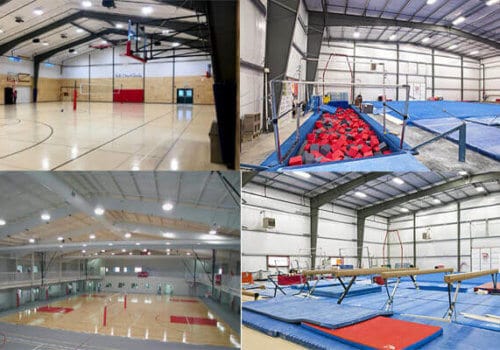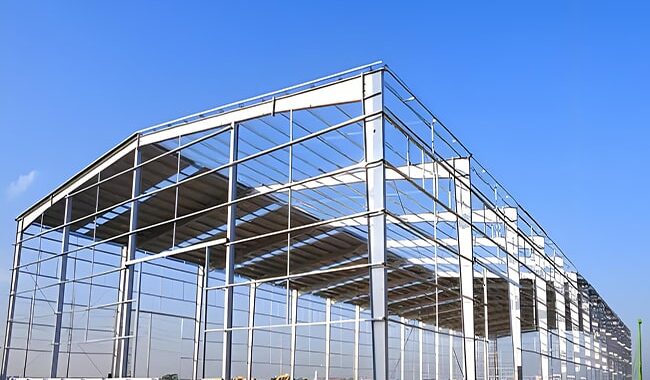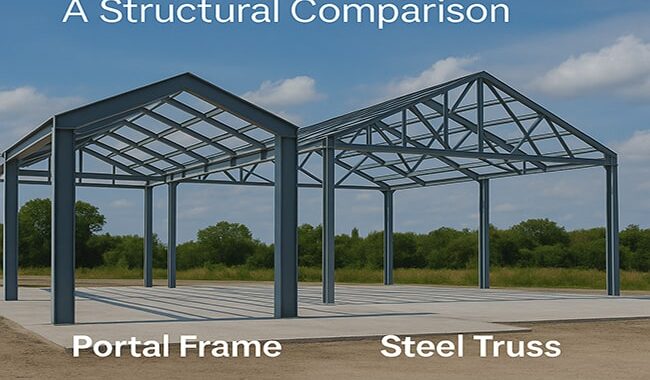A steel portal frame structure is a type of low-rise building composed of steel columns and rafters joined by rigid…
H-shaped steel is an economical cross-section and high-efficiency profile with a more optimized cross-sectional area distribution and a more reasonable strength-to-weight ratio. It is named because its cross-section resembles the English letter “H.” Since all parts of H-shaped steel are arranged at right angles, it has the advantages of strong bending resistance in all directions, simple construction, cost-saving, and light structural weight, and it has been widely used.
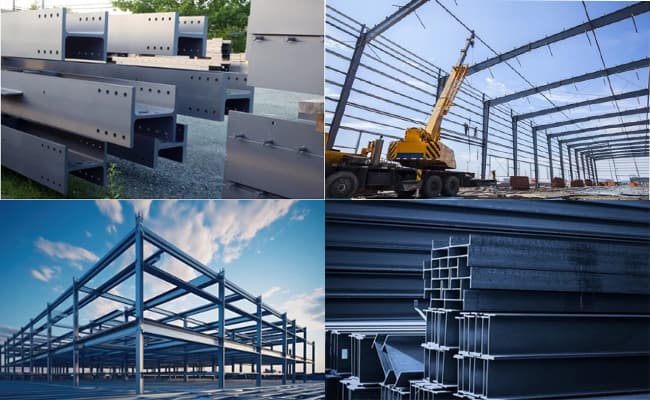
Applicable scope of H-shaped steel
H-type steel is mainly used in industrial and civil structures as beam and column components.
Steel structure load-bearing supports for industrial structures.
Steel piles and supporting structures for underground projects
Industrial equipment structures such as petrochemical and electric power
Long-span steel bridge components
Ship and machinery manufacturing frame structures
Train, car, tractor beam supports
Port conveyor belt, high-speed baffle bracket
H-shaped steel is an economical cross-section steel widely used in industry, construction, bridges, oil drilling platforms, etc.
Introduction to H-shaped steel
It is divided into hot-rolled and welded.
Hot-rolled
Hot-rolled H steel is divided into three types: wide-flange H-shaped steel (HW), medium-flange H-shaped steel (HM), and narrow-flange H-shaped steel (HN).
HW is an H-shaped steel whose height and flange width are equal; it is mainly used for steel core columns in reinforced concrete frame structure columns, also called stiff steel columns; it is primarily used for columns in steel structures.
HM is the ratio of H-shaped steel height to flange width, roughly 1.33~~1.75. Mainly used in steel structures: used as steel frame columns and frame beams in frame structures that bear dynamic loads, for example, equipment platforms.
HN is an H-shaped steel whose height-to-flange width ratio is greater than or equal to 2 and is mainly used for beams; the use of I-shaped steel is equivalent to that of HN-shaped steel;
The primary materials of H-shaped steel are Q235B, Q355B, etc.
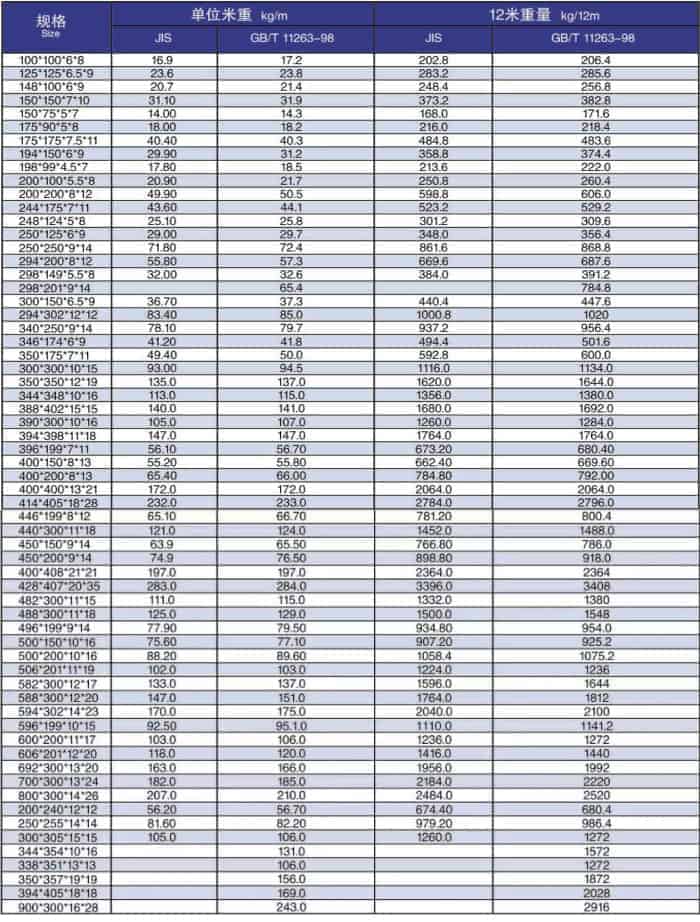
Welding H-shaped steel:
Welded H steel is processed and manufactured using the H-shaped production line for assembly and welding. First, the web plate and one of the flange plates are assembled into a T shape on the H-shaped steel automatic assembly machine, and then the T shape is assembled with the other flange plate into an H-shaped member. After passing the test, it will be transferred to subsequent processes.
Critical points in the processing and manufacturing process of welded H-shaped steel components should be paid attention to the following aspects:
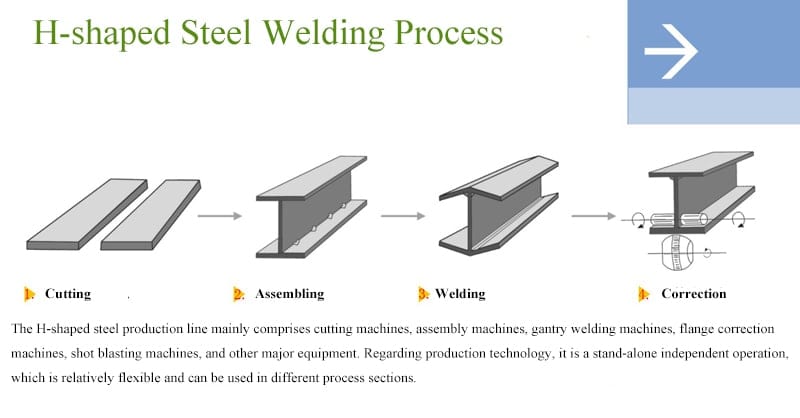
1. Cutting
Before welding the H-shaped steel web and flange plates, use a leveling machine to level the steel plates. The cutting equipment mainly uses
Use a flame multi-head straight strip cutting machine. When cutting, multiple boards are cut at the same time to prevent side bending of the parts after cutting.
Before cutting, you should carefully check whether the steel plate’s material, specification, and size are correct. Only when they are right can you proceed to cutting. At the same time, the unevenness of the steel plate should be checked. The unevenness should be leveled first if it exceeds the “Construction Specifications” provisions.
Before cutting, remove rust, oil, and other debris on the surface of the steel plate to ensure cutting quality. After cutting, the oxide scale and sulfur residue on the cutting surface should be removed and transferred to the following process. Cutting tolerances and quality should meet the “Construction Specifications.”
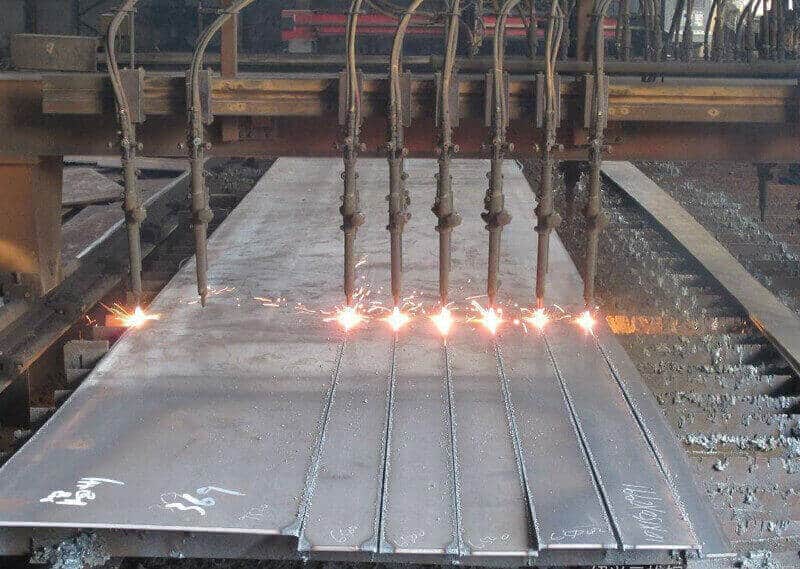
2. H-shaped steel assembly
Before assembling the welded H-shaped steel, the flange plate’s center line and the web plate’s positioning line should be marked. At the same time, the correctness of the flange plate, web number, material, size, and quantity should be checked. Assembly can only be carried out after passing the test.
When assembling on the H-shaped steel automatic assembly machine, first assemble the T-shaped flange plate and web plate and perform positioning welding. Then, assemble the T shape and flange plate to form an H shape. When assembled, the joints of the flange plates and the web joints should be staggered by more than 200mm.
When assembling H-shaped steel tire frames, the platform and tire frame used for assembly should meet the accuracy requirements of component assembly and have sufficient strength and stiffness. They must be inspected by full-time personnel before assembly before use.
Cracks or pores are strictly prohibited in the positioning weld when welding the H-shaped steel assembly. Positioning welding must be performed by welders holding corresponding certificates, and the welding materials used are the same as those used in formal welding. When preheating is required for positioning welding, the preheating temperature should be higher than the preheating temperature for formal welding.

3. H-beam welding
After the H-shaped steel assembly is qualified, it is hoisted into the gantry-type automatic submerged arc welding machine for welding. Before welding, rust, burrs, oxides, oil, and other impurities in the weld area should be removed. First, add arc starting plates and arc extinguishing plates with the same material as the components at both ends. The lead-out length of the welding seam should not be less than 50mm. Then, ceramic electric heaters were used to preheat within 100mm of both sides of the weld. The preheating temperature is 80 to 120°C. Use an infrared thermometer to measure during the heating process to prevent the heating temperature from being too high. Wait until the temperature is reached. Then, welding can be carried out.
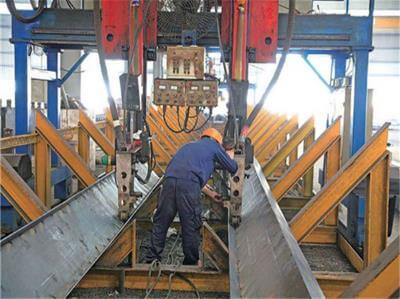
The welding method adopts portal submerged arc welding for automatic welding. If the plate thickness is less than 40mm, each weld should be fully welded at one time and then turned over accordingly. If the web thickness is greater than 40mm, each weld should not be fully welded at one time, and the welding deformation can be reduced by turning over and turning multiple times.
When performing submerged arc welding, the welding leg’s height should meet the design drawing’s requirements. During the welding process, the position of the welding wire should be observed and adjusted in time to avoid welding wire deviation. If an arc breaks during the welding process, the weld at the joint should be ground to a transition slope of not less than 1:4 before welding can continue.
After the welding is completed, remove the slag on the surface of the weld and the spatter on both sides, use gas cutting to cut off the arc starting plate and the lead-out plate, grind the cuts smooth, and it is strictly forbidden to knock them off with a hammer.
4. Welding H-shaped steel correction
Welding H-shaped steel should be corrected after welding is completed. The correction can be divided into two forms: mechanical correction and flame correction. The welding angle deformation is mechanically fixed by flame baking or an H-shaped steel flange correcting machine. The corrected steel surface should not have noticeable scratches or damage; the scratch depth shall not exceed 0. 5mm. Bending and twisting deformations are updated by flame, the correction temperature is controlled at 800 to 900°C, and there must be no overturning.
H-shaped steel is a new type of economical construction steel.
H-shaped steel has an economical and reasonable cross-section shape and good mechanical properties. During rolling, the extension of each point on the cross-section is relatively uniform, and the internal stress is minor.
Compared with ordinary I-beam steel, it has the advantages of large section modulus, lightweight, and metal saving, which can make buildings. The structure is reduced by 30-40%.
Because the inner and outer sides of the legs are parallel and the leg ends are at right angles, they can be assembled into components, saving 25% of the welding and riveting workload.
It is often used in large buildings (such as factories, high-rise buildings, etc.) that require large interception capacity and good cross-sectional stability, bridges, ships, lifting and transportation machinery, equipment foundations, brackets, foundation piles, etc.
H-shaped steel is an economical cross-section steel optimized and developed from I-shaped steel with better cross-section mechanical properties. In particular, the cross-section is the same as the English letter “H,” so it is named after it. Its characteristics are as follows:
The flange is wide, and the lateral stiffness is high—strong bending resistance, about 5%-10% better than the I-beam.
The two surfaces of the flange are parallel, making connection, processing, and installation easy.
Compared with welded I-beams, it has low cost, high precision, minor residual stress, no need for expensive welding materials and weld inspection, and saves about 30% of steel structure production costs.
Under the same cross-sectional load. The hot-rolled H steel structure is 15%-20% lighter than the traditional one.
Compared with concrete structures, hot-rolled H steel structures can increase the usable area by 6%, while the structure’s dead weight is reduced by 20% to 30%, reducing the internal stress of the structural design.
Analysis of characteristics of H-section steel
High structural strength:
Compared with I-beam, the section modulus is more significant, and 10-15% of metal can be saved under the same load-bearing conditions.
Flexible and rich design styles:
When the beam height is the same, the bays of the steel structure can be 50% larger than those of the concrete structure, making the building layout more flexible.
The structure is light in weight:
It is lighter than the self-weight of a concrete structure. The reduction of the self-weight of the structure reduces the internal forces of the structural design, which can lower the foundation treatment requirements of the building structure, the construction is simple, and the cost is reduced.
High structural stability:
The steel structure, mainly made of hot-rolled H-shaped steel, has a scientific and reasonable structure, good plasticity and flexibility, and high structural stability. It is suitable for building structures that withstand significant vibration and impact loads. It strongly resists natural disasters and is especially ideal for some multi-purpose buildings. It is building structures in earthquake zones. According to statistics, when a devastating earthquake of magnitude seven or above occurs worldwide, steel structure buildings dominated by H-shaped steel suffer the most minor damage.
Increase the effective use area of the structure:
Compared with concrete structures, the cross-sectional area of steel structure columns is small, which can increase the effective use area of the building. Depending on the different forms of the building, the effective use area can be increased by 4-6%.
Save labor and materials:
Compared with welding H-shaped steel, it can significantly save labor and materials, reduces the consumption of raw materials, energy, and labor, has low residual stress, and has good appearance and surface quality.
Environmental protection:
The use of H-shaped steel can effectively protect the environment, which is reflected in three aspects: first, compared with concrete, dry construction can be used, which produces less noise and less dust; second, due to the reduced weight, less soil is required for foundation construction, causing minor damage to land resources, in addition to significantly reducing the amount of concrete and the amount of excavation, which is conducive to the protection of the ecological environment; thirdly, after the service life of the building structure expires, the amount of solid waste generated after the structure is dismantled is small, and scrap steel resources are recycled High value.
The high degree of industrial production:
The steel structure, mainly made of hot-rolled H-shaped steel, has a high degree of industrial production, which is convenient for mechanical manufacturing, intensive production, high precision, easy installation, and easy to ensure quality. It can be built into a real house manufacturing factory, bridge manufacturing factory, Industrial plant, etc. The development of steel structures has created and promoted the development of hundreds of emerging industries.
The project construction speed is fast:
It occupies a small area, is suitable for all-weather construction, and is less affected by climate conditions. The construction speed of steel structures made of hot-rolled H-shaped steel is about 2-3 times that of concrete structures. The capital turnover rate is doubled, which reduces financial costs and thus saves investment.
